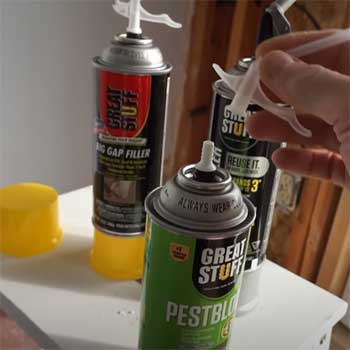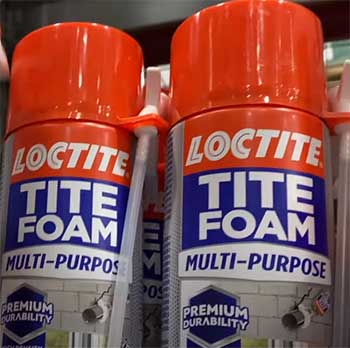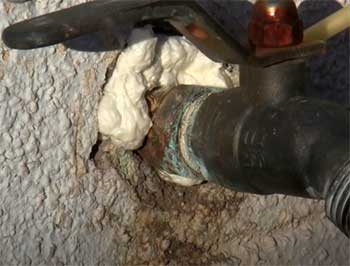Expanding foam sealants like Great Stuff and Loctite are handy solutions for filling gaps, sealing cracks, and insulating spaces in your home. But with so many options on the market, how do you choose the right one for your specific project?
In this comprehensive guide, we’ll compare the key features, pros and cons of Great Stuff versus Loctite expanding foams to help you pick the best product for your needs.
A Brief Comparison Table
| Criteria | Great Stuff | Loctite |
| Manufacturer | Dow Chemical | Henkel Corporation |
| Main Uses | Home insulation, sealing cracks and gaps | Construction bonding and filling |
| Formulas Available | Gaps & Cracks, Window & Door, Big Gap Filler, Pestblock | Window & Door, Gaps & Cracks, Big Gap Filler, Construction Adhesive |
| Application Method | Built-in nozzle | Requires applicator gun |
| Expansion Rate | Expands up to 3X size | Minimal controlled expansion |
| Cure Time | 8-12 hours | 16-24 hours |
| Bonding Strength | Moderate | Maximum strength |
| Cost | $4-$8 per can | $5-$10 per can |
| Ease of Use | Very easy | Moderate learning curve |
| Clean Up | Acetone to remove excess | Acetone and applicator cleaning |
| Availability | Hardware stores | Hardware and construction stores |
| Target User | DIYers | Professionals |
Overview of Great Stuff and Loctite Expanding Foams
Great Stuff and Loctite are two leading brands of polyurethane-based expanding foam sealants. Here’s a quick rundown of each product line:
Great Stuff

- Manufactured by Dow Chemical Company
- Available in multiple formulations for various applications
- Comes in pressurized cans with attached application straws
- Expands up to 3 times original size to fill cavities
- Forms permanent, airtight and waterproof seal
Loctite
- Manufactured by Henkel Corporation
- Mainly geared towards construction applications
- Offered in minimalist cans without applicator tips
- Expands minimally compared to Great Stuff
- Creates rigid, gap-filling foam barrier
While both products are polyurethane foams, Loctite is generally denser with lower expansion compared to Great Stuff. Great Stuff offers a wider range of specialty formulations too.
Now let’s go over the key factors to consider when choosing between these two popular brands.
Key Comparison Factors Between Great Stuff and Loctite Foams
Here are the most important factors to weigh when deciding between Great Stuff and Loctite expanding foam for your insulation, sealing or fastening needs:
1. Intended Use and Application
The first consideration is your specific project requirements. Great Stuff offers various formulas for different applications:
- Great Stuff Gaps & Cracks – Filling everyday cracks and gaps around the home
- Great Stuff Window & Door – Sealing frames and jambs
- Great Stuff Big Gap Filler – Filling larger gaps up to 3 inches
- Great Stuff Pestblock – Blocking insects and pests from entering the home
Whereas Loctite focuses more on construction applications like:
- Loctite TITE FOAM Window & Door – Sealing windows and doors
- Loctite TITE FOAM Gaps & Cracks – Filling cracks and gaps
- Loctite TITE FOAM Big Gap Filler – Filling gaps up to 4 inches
- Loctite PL Premium Polyurethane Construction Adhesive – An all-purpose adhesive for building materials
So consider which specific project you need the foam for before deciding on Great Stuff or Loctite.
2. Cure Time
The amount of time the foam takes to fully expand and cure is another key factor.
Great Stuff formulas generally have quicker cure times of around 8-12 hours for most projects, while Loctite foams take 16-24 hours to fully cure in most cases.
If you need to move fast and don’t want to wait overnight for the foam to cure, Great Stuff may be a better choice. But for large gaps that require slow, controlled curing, Loctite foams are often preferred.
3. Expansion Rate

As mentioned above, Great Stuff foams generally expand more than Loctite, up to 3 times their original size.
So for filling very large voids, Great Stuff can provide greater filling capacity.
However, for construction applications when you want to control expansion more precisely, Loctite’s minimal expansion may work better.
The slow, controlled expansion of Loctite makes it easier to gauge the proper amount of foam required.
4. Strength and Durability
Both Great Stuff and Loctite make permanent, rigid foams designed for long-term applications once fully cured. Most formulations can last for many years if applied correctly.
That said, Loctite foams tend to create stronger structural bonds on building materials like wood, metal and concrete. So for high-strength bonding and construction jobs, Loctite has a slight edge.
5. Ease of Application
Great Stuff foam comes in pressurized cans with a built-in nozzle for convenience. Loctite foam typically requires a separate applicator gun for most home projects.
So Great Stuff provides a bit more convenience and easier DIY application. However, the applicator gun allows for more control when applying Loctite foam.
6. Price and Availability
Both Great Stuff and Loctite are available at most hardware stores. Great Stuff tends to be slightly more affordable at around $4 to $8 per can, while Loctite costs $5 to $10.
Loctite is primarily marketed at construction contractors, while Great Stuff targets everyday DIYers. So you may find a wider selection of Great Stuff products locally.
Pros and Cons of Great Stuff And Loctite Foam
Based on the above comparisons, here is a quick rundown of the main pros and cons of using Great Stuff or Loctite expanding foam sealant for your projects:
Great Stuff Pros
- Wide range of specialized formulations
- Faster cure time in most cases
- Greater expansion capacity for filling large gaps
- Easier DIY application from built-in nozzle
- Very affordable for homeowners
Great Stuff Cons
- Not designed for structural strength
- More precision required to avoid over-expansion
- Can be messy for larger projects
Loctite Pros
- Better bonding strength and durability
- Controlled expansion rate
- Applicator gun allows greater control
- Primarily designed for building materials
- Professional grade for contractors
Loctite Cons
- Limited specialty formulations
- Slower cure time
- Separate applicator gun required
- More expensive than Great Stuff
- Harder to gauge required usage
So as you can see, Great Stuff is generally the preferable option for simple DIY home sealing and insulation projects thanks to its convenience and affordability.
For heavy-duty construction jobs where strength and durability are critical, Loctite is the better professional-grade choice.
Choosing the Right Expanding Foam for Your Project
When choosing between Great Stuff and Loctite, start by clearly defining your particular project requirements in terms of application, cure time, expansion needs, and strength.
Here are some general guidelines on when to use each brand:
When to Use Great Stuff
- Sealing small cracks and gaps around the home
- Filling everyday cavities in walls, attics, basements
- Insulating pipes and ductwork
- Installing new vinyl windows or exterior doors
- Quick overhead sealing projects
- Small DIY jobs with minimal expansion needed
When to Use Loctite
- Heavy duty construction projects
- Building or repairing decks, fences, etc.
- Installing doors on masonry, concrete, or stone
- Anchoring bolts, screws, rods into solid materials
- Filling larger gaps that need controlled expansion
- Professional jobs where strength is critical
- Projects where you’ll reuse the applicator gun
Additionally, look for the specific formulation suited for your particular application from each brand:
Great Stuff Formula Guide
- Gaps & Cracks – Good all-purpose formula for most tasks
- Window & Door – For better adhesion around frames and jambs
- Big Gap Filler – Maximum expansion for large voids
- Pestblock – When blocking insects is the priority
Loctite Formula Guide
- TITE FOAM Window & Door – For window and door frames
- TITE FOAM Gaps & Cracks – All-purpose for most jobs
- TITE FOAM Big Gap Filler – For large voids up to 4 inches
- PL Premium Polyurethane Construction Adhesive – Multi-material bonding
Following these guidelines will ensure you get the right foam to get your job done quickly and professionally. And always refer to the manufacturer instructions for proper application and safety precautions.
Tips for Using Expanding Foams Effectively
Here are some best practices to follow when working with expanding foam sealants:

- Carefully read all safety warnings before use
- Wear gloves and eye protection
- Only apply in well-ventilated areas
- Fill gaps no more than 1/3 full to allow for expansion
- Apply in temperatures between 60-100°F for proper curing
- Allow full cure time before trimming or painting foam
- Use painter’s tape to help control excess expansion
- Cut nozzle at 45° angle to reduce stringing
- Have acetone on hand to wipe away excess foam
- Use slow, steady pressure on the trigger or gun
- When reusing Loctite applicator gun, wipe nozzle before storing
Follow these tips and the product instructions for best results from your expanding foam project.
Frequently Asked Questions (FAQ)
Loctite foam generally provides greater bonding strength than Great Stuff, especially for building materials. The construction-grade Loctite formulas are designed to provide rigid, durable bonds.
Fully cured Loctite foam offers excellent strength as a polyurethane adhesive and sealant. For example, Loctite PL Premium can bond materials up to 2500 psi when compressed. Great Stuff has lower bonding power more suitable for home DIY jobs.
For insulating large areas like attics, most professionals recommend closed-cell spray foam from qualified applicators. But for small DIY insulating jobs, Great Stuff works well to seal cracks, gaps, and cavities.
Avoid using expanding foam sealant near high heat sources like chimneys, heat vents, and exposed light fixtures. Also don’t fill gaps near sprinklers or plumbing fixtures. Follow all manufacturer guidelines on proper usage.
Conclusion
When comparing Great Stuff and Loctite spray foams, consider your specific project, application, cure time, and bonding strength needed. For most basic DIY sealing jobs at home, Great Stuff is the best option due to its convenience, affordability and range of formulas.
For heavy-duty construction projects, Loctite offers greater strength and control. Following these tips will ensure you choose and apply the right foam sealant for your needs.

Excellent break down & structure of your article! I’m bookmarking this page for reference. I have no experience, so I will add to this comment if any thoughts come to mind during my projects!